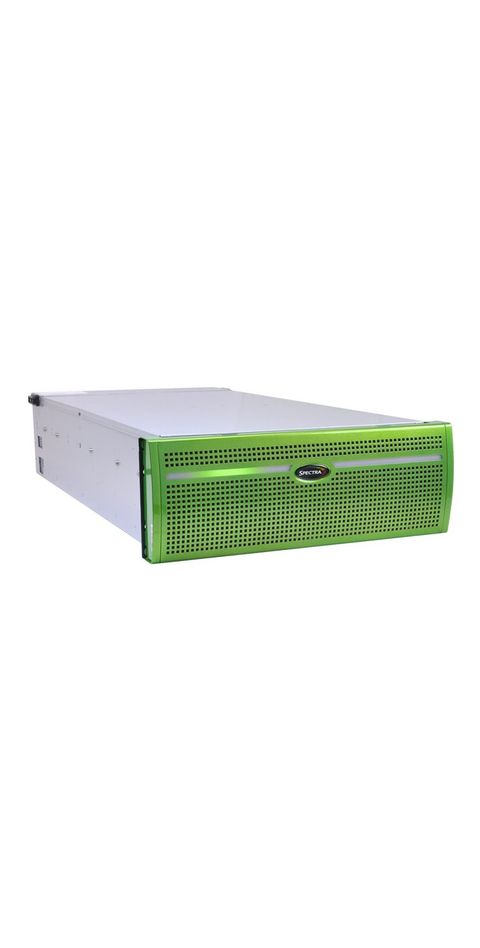IT Pro Verdict
Enterprises looking for a low-cost, easily deployed and reliable long-term data archive will love the high capacity Verde DPE
Pros
- +
Very low storage costs; Good read performance; Triple-parity reliability; Huge expansion potential
Cons
- -
SMR hits write performance
As tape drive and media sales continue to decline, storage vendors are looking for new and innovative solutions for long-term data backup and archiving. Spectra Logic's Verde DPE (data preservation enterprise) NAS appliances offer an interesting alternative as they use SMR (shingled magnetic recording) hard drives to deliver ultra-low storage costs.
Whereas traditional PMR (perpendicular magnetic recording) drives lay down tracks on the disk platter in parallel, SMR overlaps them. Similar to house roof shingles, this allows track density to be increased which keeps storage costs down as the drives can use fewer platters.
The main issue with this technology is reduced write performance. SMR write heads are larger than each shingled track so when data is updated or new data is written, the drive has to correct data overwritten on subsequent tracks.
There are a number of methods for managing this process with host aware and host managed SMR solutions requiring the host OS to handle this. The Verde DPE uses Seagate's 8TB SATA Archive HDDs which employ on-board drive managed SMR so they handle write correction transparently.
Big storage capacity
The Verde DPE hardware comprises a Supermicro 4U storage-optimised chassis and X10DRH-iT motherboard. The chassis has 24 LFF hot-swap bays at the front, a further 12 LFF at the rear and two mirrored SFF drives tucked away beside the dual, hot-plug PSUs and preloaded with Spectra Logic's ZFS-based OS.
The master unit is supplied with the storage bays populated with 8TB drives for a top raw capacity of 200TB. It supports up to nine 4U expansion nodes which each have 98 top-loading bays allowing raw capacity to be pushed an impressive 7.4PB.
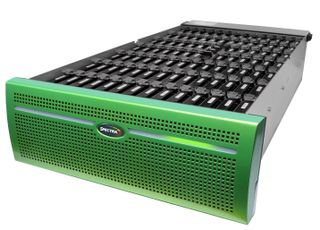
The Verde DPE support up to nine expansion nodes, each with 98 drive bays
The system has dual embedded 10GBase-T ports with the first dedicated to management duties. You also get a dual-port 10GbE SFP+ PCI-E card. Multiple data ports can be aggregated into high-speed links with one virtual IP address using DHCP or up to sixteen IP addresses using static link aggregation.
Storage provisioning
The appliance's web console is easy to use, although it is looking dated and in need of a refresh. Provisioning starts by creating a storage pool and the Verde DPE is restricted to a single 23-drive pool using triple parity and dual global hot-spares. Note also, that although pools can be expanded in size as required, this must be done in 23-drive increments.
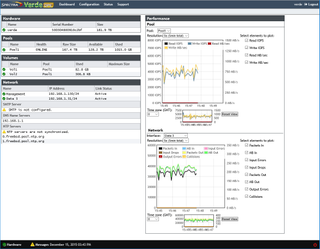
The basic web console provides a simple status view of storage usage and performance
Volumes are created within a pool where we entered a minimum and maximum size, enabled compression and opted for read only or read/write access. Thin provisioning is automatically applied and this uses the pool high watermark to issue alerts if space gets low.
CIFS and NFS shares are supported and each type requires a dedicated volume. Host access to CIFS shares is automatic if the appliance has joined an Active Directory domain while in workgroup mode, each one must log in using the local CIFS administrative account.
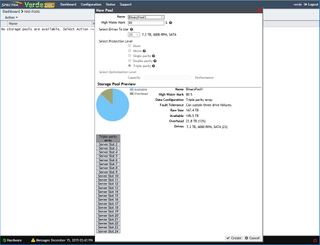
Storage pools can only be provisioned in blocks of 23 drives with triple parity
Performance
For performance testing, we used an HP ProLiant DL380 Gen9 rack server equipped with dual 2.3GHz E5-2695 v3 Xeons, 64GB of DDR4 plus an Emulex 10GbE fibre adapter with Windows Server 2012 R2 at the helm.
With a CIFS share mapped to the server, we saw Iometer record a top raw sequential read rate of 1,178MB/sec which equates to a tidy 9.2Gbits/sec. SMR made its presence felt as raw write speeds were much lower with Iometer reporting 306MB/sec.
With a second share mapped to another Xeon E5-2600 v3 server, we reran Iometer on both systems. Cumulative read speeds didn't improve but write speeds crept up slightly to 322MB/sec.
For real world testing, we copied a 25GB test file to and from the share and saw sustained read and write speeds of 732MB/sec and 287MB/sec. To test backup performance, we copied our standard 22.4GB folder and its 10,500 small files to a share which averaged 180MB/sec write speeds.
Snapshots and Black Pearl
Snapshots are created at the volume level and can be run on-demand and scheduled for regular hourly, daily or weekly intervals. Individual file and folder restoration is a cinch as all snapshots are exposed with the mapped drive so they can be recovered using drag and drop.
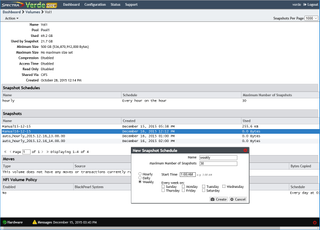
Volume snapshots can be scheduled and provide fast rollback services
Full volume recovery is equally pain-free. We deleted 22GB of data from a CIFS share, chose a snapshot, applied rollback and had everything reinstated in under 5 seconds.
The Verde DPE also supports Spectra Logic's BlackPearl object storage gateway which provides enterprises with a low-cost, deep archiving solution. After a BlackPearl system is linked to the Verde DPE, you can create volumes with NFI (network file interface) policy schedules which copy data to a BlackPearl bucket and either keep the source on the Verde or delete it.
The BlackPearl transfers objects to an attached tape library or Spectra Logic's latest ArcticBlue SMR-based object storage arrays. If an NFI policy requests it, the data is then deleted from the Verde and should a user request it again, the BlackPearl automatically reinstates it from deep storage.
Conclusions
The Verde DPE delivers massive storage capacity for the price and teams this up with impressive expansion potential. SMR does have a big impact on write performance, but Spectra Logic's ZFS-based RAID Z3 implementation provides excellent reliability and the appliance is very simple to deploy.
Verdict
Enterprises looking for a low-cost, easily deployed and reliable long-term data archive will love the high capacity Verde DPE
Chassis: Supermicro 4U rack chassis
Motherboard: Supermicro X10DRH-iT motherboard
CPU: 2 x 2.4GHz Intel Xeon E5-2620 v3
Memory: 64GB DDR4
Storage: 2 x Seagate 250GB SFF SATA; 24 x 8TB Seagate Archive HDD SATA
RAID: ZFS triple-parity
Network: 2 x 10Gbase-T, 2 x 10GbE SFP+ (1 x management, 3 x data)
Expansion: Optional 10GbE PCI-Express and SAS PCI-Express expansion cards
Power: 2 x 1280W hot-plug PSUs
Dave is an IT consultant and freelance journalist specialising in hands-on reviews of computer networking products covering all market sectors from small businesses to enterprises. Founder of Binary Testing Ltd – the UK’s premier independent network testing laboratory - Dave has over 45 years of experience in the IT industry.
Dave has produced many thousands of in-depth business networking product reviews from his lab which have been reproduced globally. Writing for ITPro and its sister title, PC Pro, he covers all areas of business IT infrastructure, including servers, storage, network security, data protection, cloud, infrastructure and services.
